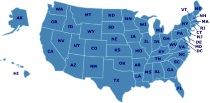Native Americans
Things to See & Do in Ohio
Hopewell Culture National Historical Park
From about 200 BC to AD 500, the Ohio River Valley was a focal point of the prehistoric Hopewell culture. The term Hopewell describes a broad network of beliefs and practices among different Native American groups over a large portion of eastern North America. The culture is characterized by the construction of enclosures made of earthen walls, often built in geometric patterns, and mounds of various shapes. Visible remnants of Hopewell culture are concentrated in the Scioto River valley near present-day Chillicothe, Ohio. The most striking Hopewell sites contain earthworks in the form of squares, circles, and other geometric shapes. Many of these sites were built to a monumental scale, with earthen walls up to 12 feet high outlining geometric figures more than 1000 feet across. Conical and loaf-shaped earthen mounds up to 30 feet high are often found in association with the geometric earthworks. The park contains nationally significant archeological resources including large earthwork and mound complexes that provide an insight into the social, ceremonial, political, and economic life of the Hopewell people. The park visitor center features museum exhibits, an orientation film, book sales area, and self-guided and guided tours.
Featured Resources
As an Amazon Associate, we earn from qualifying purchases. We get commissions for purchases made through links on this site.
Greenleaf Press
Greenleaf Press is a small family-owned and operated publisher and supplier of quality books for children. They are committed to "twaddle-free", living books, and approach teaching history to children using biography and chronology. You will find sections in the catalog covering each major historical period in order, with a variety of biographies, reference books, and historical fiction. For Israel, Egypt, Greece, Rome, the Middle Ages, and the Renaissance and Reformation there are Greenleaf Stu...
Kids' Poems (Grades 1)
Regie Routman shares her delightful selection of free verse poems written by first graders that will inspire your second graders to think, I can write poems like this too! Regie provides strategies for using kids' poems as models to guide children to write poems about things they know and care about: learning to skate, disliking asparagus, playing with a best friend, and more. She describes the way she invites children to study the model poem, beginning by asking kids, What do you notice? She sh...
Homeschoolers' Success Stories : 15 Adults and 12 Young People Share the Impact That Homeschooling Has Made on Their Lives
Despite their growing numbers, many homeschoolers still find their experience somewhat isolating. This collection of short biographies aims to alleviate some of that loneliness. While the stories profile modern-day homeschool grads and students, famous homeschooled personalities from the past are offered up early in the book for historical inspiration. John Adams, Abraham Lincoln, steel magnate Andrew Carnegie, newspaper publisher Joseph Pulitzer, photographer Ansel Adams, poet Robert Frost, and...
Right-Brained Children in a Left-Brained World: Unlocking the Potential of Your ADD Child
Understanding your child's learning style can help with challenges in learning, improving outcomes in reading, writing, and behavior. This book offers strategies for understanding your child's learning style and presents tools that you can use to become more successful in your homeschooling.
Parenting With Grace: Catholic Parent's Guide to Raising Almost Perfect Kids
Gary Popcak and his wife Lisa show that God offers every Catholic parent guidance and the opportunity to take a truly Catholic approach to parenthood. In this book, they discuss parenting strategies, phases children go through, the essential differences between discipline and punishment, and more.




